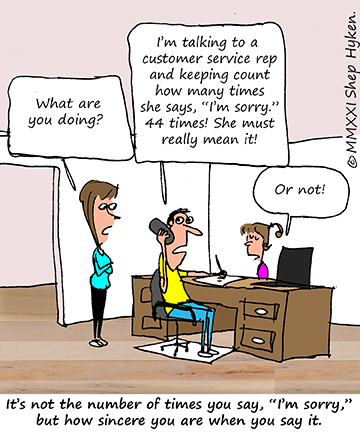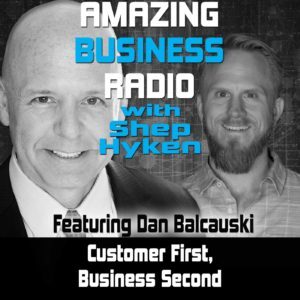Shep Hyken's Blog, page 75
November 2, 2021
Amazing Business Radio: Colin Shaw
 Customer Experience Is Science
Customer Experience Is ScienceCreating Proactive Customer Experiences
Shep Hyken interviews Colin Shaw, co-host of the Intuitive Customer podcast and the Founder & CEO of Beyond Philosophy LLC, a customer experience consulting company that has been recognized by the Financial Times as ‘one of the leading management consultancies for the last three years in a row. They discuss how companies can use customer science to provide positive and memorable customer experiences.






 Top Takeaways:
Top Takeaways:When was the last time that an organization did something for you that you weren’t expecting?
Perhaps it was to email you if you needed a refill of a product that you previously ordered. Or, to show you articles and videos of how you can maximize the use of something you purchased from them. Whatever it was, it was a pleasant surprise.
The world’s leading companies like Apple, Airbnb, Amazon, and many more are becoming so in tune with not only what the customers say they want, but they also know how their customers behave and what they feel. They can accurately predict what their customers are going to do next – and what they will want next.
This week on Amazing Business Radio, I interview Colin Shaw, Founder & CEO of Beyond Philosophy LLC, to talk about understanding the customers in an even deeper way through customer science, behavioral science, and the journey map.
Customer science is the fusion between technology, data, and behavioral science.Behavioral science is looking at what customers are doing as opposed to looking at what customers are saying they are doing.The journey map is looking at the customer journey from the customer’s perspective.If you can predict what the customer is going to do next, will it change the way you create customer experiences?
Quotes:“The average organization doesn’t understand behavioral science. They don’t collect data on what emotions a customer is feeling.”
“According to Daniel Kahneman, “We don’t choose between experiences, but we choose between memories of experiences.” You can’t be loyal to something that you haven’t experienced.”
About:Colin Shaw is the Founder & CEO of Beyond Philosophy LLC, a customer experience consulting company that has been recognized by the Financial Times as ‘one of the leading management consultancies for the last three years in a row. He is the co-host of the highly successful Intuitive Customer podcast, which is rated in the top 5% of all podcasts globally by Buzzsprout.
Shep Hyken is a customer service and experience expert, New York Times bestselling author, award-winning keynote speaker, and your host of Amazing Business Radio.
This episode of Amazing Business Radio with Shep Hyken answers the following questions … and more:
What is customer science?How do you identify customer behavior?Does AI improve customer service?What is a customer journey map?Why is customer segmentation important?The post Amazing Business Radio: Colin Shaw appeared first on Shep Hyken.
November 1, 2021
5 Top Customer Service Articles of the Week 11-1-2021
Each week I read many customer service and customer experience articles from various resources. Here are my top five picks from last week. I have added my comment about each article and would like to hear what you think too.
Customer Service Is Free by Seth Godin(Seth’s Blog) Customer service is expensive. But all of that expense–it’s the cheapest way to spread the word about what you do.
My Comment: We start with a very short article from business guru, Seth Godin. Short, in this case, means a 45-second read, but as the saying goes, “Good things come in small packages.” The message is clear and powerful!
3 Customer Experience Lessons Brands Can Learn From Amazon by Scott Clark(CMSWire) Amazon’s mission statement is “We aim to be Earth’s most customer-centric company. Our mission is to continually raise the bar of the customer experience by using the internet and technology to help consumers find, discover, and buy anything, and empower businesses and content creators to maximize their success.”
My Comment: Anytime I can learn a lesson from Amazon, I jump on it. Also, this article isn’t just for the B2C world. These lessons are applicable to the B2B world, as well. Three simple and powerful lessons: meet expectations, personalization, and “commerce anywhere” experiences. Note: I use the word simple, but remember that simple does not always mean easy.
15 ‘Low-Hanging Fruit’ Actions To Help Revamp Your Customer Experience by Forbes Business Council(Forbes) Fortunately, changing up established procedures doesn’t have to require a complete overhaul. Leaders can choose the “low-hanging fruit”—easy to identify and implement—to drastically improve the customer experience without spending excessive time and resources. Not sure where to begin? Try these 15 simple, yet effective actions to help revamp your customer experience, shared by the members of Forbes Business Council.
My Comment: Our friends at the Forbes Business Council give us another great list. There are plenty of ideas for all types of businesses and industries. And most of them are somewhat easy to implement. Look them over and take a few of these ideas to your next team meeting. Never miss the opportunity to improve your CX!
How Brands Are Using Technology to Amplify the Customer Experience — Whether You’re Shopping or Ordering Fast Food by Dept(Business Insider) Connected commerce refers to a customer experience that integrates commerce across all aspects of the customer’s life. This is across any and every touchpoint, from online to in-person to everywhere in between. The only goal is to make a product as accessible as possible and make purchasing it as instantaneous as possible.
My Comment: I was intrigued by this article. It’s very retail focused, but if you’re not in retail, still take a couple of minutes to learn a new word: phygital. It’s the word to describe the connected and digital world. (By the way, if you Google the word, you get the definition from an article in 2016, but my spell check doesn’t recognize it.)
How to Create a Positive Customer Experience Through Personalization by Greg Chen(Total Retail) To say that the retail world is changing is an understatement. The constant pressure from discounters, along with the increasing power wielded by consumers, has pushed retailers to seek new effective differentiation approaches to remain competitive in the market.
My Comment: We close out this week with an article on one of my favorite topics, personalization. Our customer service research indicates that 75% of customers are more likely to the companies and brands that deliver a personalized customer service experience. While retail focused – it seems many of the articles are – the B2B company that finds way to personalize the experience will also win.
Shep Hyken[image error] is a customer service expert, professional speaker, and New York Times bestselling business author. Go to The Customer Focus to learn more about our customer service training programs. Follow on Twitter: @Hyken
to learn more about our customer service training programs. Follow on Twitter: @Hyken
The post 5 Top Customer Service Articles of the Week 11-1-2021 appeared first on Shep Hyken.
October 29, 2021
Guest Post: How to Choose the Right Call Center Software to Supercharge Your Customer Support
Sowmya J. is a content developer and a digital media strategist at Knowmax. She shares how companies can choose the call center software that fits their customer support teams.
In today’s digital world, whether your customers prefer phone support or traditional customer service, effective call center software is essential for smooth functioning. Managing a support team can be a major challenge, as well as time-consuming, and expensive. If you wish to impress your customers or live up to their expectations, you need a call center tool that enables effective work. With features that ensure support agents understand, answer, and solve customer problems, the call center will become productive and profitable.
Using a call center software that’s backed by knowledge management adds to the advantage. It boosts efficiency, spreads knowledge, ensures better content consistency, improves customer service quality thereby increasing the loyalty and trust of the customers. As a result, many establishments are utilizing call center tools that are based on KM these days.
Before you decide upon a call center system for your organization, consider the following: OmnichannelSupporting customers through multiple communication channels requires effort and money. Your call center knowledge base must integrate with all of the channels. An omnichannel system reduces buyer friction and enhances efficiency. It allows calls to be logged on for follow-up later. This way, every team member is aware of all the customer interactions, thereby creating a consistent customer experience (CX) no matter which channel the interaction begins on.
Call routingIt is extremely viable for customers to reach the right person in charge to guide them through. Whether your call center software has in-built call routing, or it requires a set of options to be chosen by customers, it should have this feature.
Cloud-based callingCloud networks are significant to the functioning of a contact center and need a cloud-based calling system to align with. Easier to handle and less expensive than regular landlines, this doesn’t require on-premise hardware- eliminating maintenance fees that regular phones may charge.
CRM integrationCustomers have to keep track of their previous interactions and repeat their problems or inquiries until they are solved. But if agents have an understanding of who’s calling, they can provide effective support and state progress. This smoothens the process and enhances the experience of the customers.
Outgoing callsCall center tools should include the feature that lets agents make outbound calls. Some specific features like an automated dialer, call logging, and more enable your CRM to stay relevant.
Call scriptingContact centers receive volumes of calls and a call center script makes life easier for the support agents. With call scripting, your agents can practice and prepare before interacting with customers. They can also track interactions if needed. Another advantage is, one can create common scripts for all the staff and maintain consistency.
Interactive voiceAn interactive voice feature enables your customers to interact with an automated system before talking to someone from the support team. This way, common issues can be resolved and basic information can be provided to clear doubts. This saves your agents’ time and only involves them when needed
When you use a call center software that bears all these features, your contact center will never be the same. Its costs and resources will decrease, consistency will increase, and agents, as well as customers, will feel satisfied. To enhance the positive impact of such features, using a call center tool that’s based on knowledge management would be advisable.
Here’s why:
The Benefits of KM-based contact center systems: CollaborationThe feature of knowledge management (KM) based contact center software enables collaboration by helping its agents to directly contact other professionals within their organization or team. This way, all of them can discuss, share, and come up with accurate solutions, or recommendations, and post tiny notes to guide others following the process.
Easier SearchesKnowledge management (KM) is known for its ability to organize and better utilize information. So naturally, a KM-based software for call centers makes easier searches possible. The content that is stored in the knowledge base is segregated into different categories, adding a structure to the information and making it simpler to find. This way agents can also find appropriate answers to queries on time and resolve problems faster
AnalyticsKnowledge base software provides analytical insights as to what the customers are calling you for. Using this information you can better train and prepare your employees on the most frequent subjects. This means your team’s ability to tackle problems faster, and more efficiently.
At the end of the day, an organized knowledge management-supported contact center system can do wonders. From reducing costs to enhancing the knowledge of the team, it is capable of so many things. Adding it to your call center makes the life of your support staff easier. They become confident, proficient, and lead to a better customer experience. Customers feel like they understand you better, and you, them. They trust your brand more and stay loyal to it. A win-win for all. Therefore when you choose your call center software, make sure it’s most suitable for your work, for that’ll make all the difference.
Sowmya J. is a content developer and a digital media strategist. Graduated from LSR college, she currently works at Knowmax.
 For more articles from Shep Hyken and his guest contributors go to customerserviceblog.com.
For more articles from Shep Hyken and his guest contributors go to customerserviceblog.com.
Read Shep’s latest Forbes article: Ten Favorite Customer Service Quotes—And What They Mean To You
The post Guest Post: How to Choose the Right Call Center Software to Supercharge Your Customer Support appeared first on Shep Hyken.
October 27, 2021
Dealing With Angry Customers: Be Sincere When You Apologize
 “I’m sorry.” Customers love to hear those important words, especially when they are calling about a problem or have a complaint. I briefly covered this in a recent article (The Five Best Things to Say to an Angry or Upset Customer), but I want to dive into the “I’m sorry” comment a little deeper.
“I’m sorry.” Customers love to hear those important words, especially when they are calling about a problem or have a complaint. I briefly covered this in a recent article (The Five Best Things to Say to an Angry or Upset Customer), but I want to dive into the “I’m sorry” comment a little deeper.
Not long ago I called a customer support center and early in the conversation the agent said, “I’m sorry you are experiencing this problem.” I appreciated those words. I felt that I was being heard and even understood. That was until a minute later when the agent once again said, “I’m sorry.”
That second apology almost went unnoticed. That was until she said it for the third time. And then there were the fourth, fifth, sixth, and seventh times. In four short minutes, she apologized seven times. I admit that I may have made statements to see how many times she would apologize. I realized after the third one that she was trained to say, “I’m sorry,” but she wasn’t trained on when or how often to say it.
There will be times that you feel you have to repeat yourself throughout the conversation. I’m not saying you have to only say, “I’m sorry,” one time. It’s okay, as long as you are aware and using that important phrase at the right times. Using it because you have nothing else to say can come off as insincere. It can seem as if you’re working off of a script, which is okay as long as the customer doesn’t get the sense that you’re working off of a script.
Obviously, you want to apologize for any problems toward the beginning of the conversation. You could make a statement such as, “I’m sorry for the problem you’re having. I can understand why you are frustrated. I would be too if that happened to me.” In just three short sentences, just 23 words, you have apologized for the problem, you’ve acknowledged your genuine concern and you have even shown empathy with the last statement about how you would be frustrated if it happened to you. Not a bad way to start a conversation with an angry customer.
And as a final gesture of proving you care, you may want to end the conversation with something like, “Once again, I’m sorry for the problem. I’m glad we were able to resolve it. Let me know if I can be of further assistance. Thank you for the call and thank you for your business.”
Shep Hyken is a customer service expert, keynote speaker, and New York Times, bestselling business author. For information on The Customer Focus customer service training programs, go to www.thecustomerfocus.com. Follow on Twitter: @Hyken
customer service training programs, go to www.thecustomerfocus.com. Follow on Twitter: @Hyken
(Copyright © MMXXI, Shep Hyken)
The post Dealing With Angry Customers: Be Sincere When You Apologize appeared first on Shep Hyken.
October 26, 2021
Amazing Business Radio: Dan Balcauski
 Customer First, Business Second
Customer First, Business SecondDefining Success from the Customer’s Perspective
Shep Hyken interviews Dan Balcauski, founder and principal consultant for Product Tranquility, where he focuses on helping high-volume B2B SaaS CEOs define pricing and packaging for new products. They discuss what companies can learn from subscription models about focusing on the customer’s journey and feedback.







 Top Takeaways:
Top Takeaways:Anything can be a subscription. Whether you are selling razor blades, pens, or a streaming service, the goal is to get the customers to say that they are getting enough value for your products to continue doing business with you. A subscription model solidifies the relationship between the business and the customer but it also requires a focus on customer experience.
How do companies ensure that their customers continuously get value over time so they don’t leave you for your competitors?
What are the outcomes that your customers are trying to achieve?
Most of the time businesses focus on operational efficiency, revenue, and profits. These are all great things. But, the problem is that these are not the criteria that the customer is using to define success. Companies need to understand that they are not the center of the customer’s world. We need to understand the full journey.
This week on Amazing Business Radio, I interview Dan Bacaulski, founder and principal consultant for Product Tranquility, where he focuses on helping high-volume B2B SaaS CEOs define pricing and packaging for new products. Dan takes us through how businesses can focus on the outcomes that the customer is trying to achieve and how they define success.
Learn how to put the customer first, provide value, and define success from the lens of those you serve – the customers.
Quotes:“We are not the center of our customer’s life. We need to understand the full journey. We need to ask, “What is our customer’s day to day like?” and “What are they trying to accomplish?”
“Companies get very enamored with the technology that they built and lose focus on the value that customers are getting out of it.”
“To be successful, businesses need to get a clear view of the value that they are providing based not only the metrics they use to define success, but also the metrics the customers are using to define success. It’s the customer’s definition of success that counts.”
About:Dan Balcauski is the founder and principal consultant for Product Tranquility, where he focuses on helping high-volume B2B SaaS CEOs define pricing and packaging for new products. He is a TopTal certified Top 3% Product Management Professional and also helps to teach Kellogg Executive Education course on Product Strategy.
Shep Hyken is a customer service and experience expert, New York Times bestselling author, award-winning keynote speaker, and your host of Amazing Business Radio.
This episode of Amazing Business Radio with Shep Hyken answers the following questions … and more:
What is a subscription model?Can all products become a subscription model?How do you measure customer success?What’s the difference between customer service and customer success?How do customers define value?The post Amazing Business Radio: Dan Balcauski appeared first on Shep Hyken.
October 25, 2021
5 Top Customer Service Articles of the Week 10-25-2021
Each week I read many customer service and customer experience articles from various resources. Here are my top five picks from last week. I have added my comment about each article and would like to hear what you think too.
What Kind of CX Do Customers Really Want? by Eric Krapf(No Jitter) Many customers still prefer email and voice channels for customer service requests over chatbots. But will that perception shift?
My Comment: How do customers prefer to reach out to you for help and support? Many companies are trying to move the initial contact to chatbots. This article emphasizes that customers may not be so quick to want to use an automated or digital system. Our customer service research indicates that 59% of customers prefer to go to the phone or email over digital channels. Read this article and learn more about what customers expect.
4 Ways Chatbots Can Fail at Customer Experience by Phil Britt(CMSWire) Chatbots continue to handle an increasing amount of customer support and other B2C and B2B interactions. Reports and Data expect the global chatbot market to reach $10.08 billion by 2026, representing a 30.9% compound annual growth rate from the $1.17 billion market of 2018. Chatbots are being used to take customer orders, speed interactions, increase access, generate leads, and for a variety of other uses.
My Comment: This is the perfect follow-up to the first article in our weekly roundup. The author notes that while chatbots continue to be popular with companies, customers are experiencing a CX failure. It’s simple: Chatbots can’t perform or answer “sophisticated interactions.”
Next Generation Loyalty – Part One by Braden Kelley(Braden Kelley) Marketers have an overly optimistic perspective on customer loyalty and their implementations of customer loyalty programs. The reality is that very few customers are loyal and much of what we speak of as customer loyalty is no more than repeat transaction behavior.
My Comment: This article resonated with me. I’m a big believer that the typical loyalty program is actually a marketing program. It awards points, miles, etc. for the dollars spent. It does drive repeat business, and there is nothing wrong with that, but it is actually a discount program. Loyalty is more than points. It’s about value creation. In short, don’t confuse repeat business with loyal business. While I love both, just know that there is a difference.
What is Brand Loyalty and How Can You Build It? by Pam Hughes(Pam Hughes) Everybody has brands they are loyal to. It could be their local coffee shop. For others, it may be the pub down the street. You might even feel connected to a brand you haven’t purchased from but are still interested in. Trust is the most common source of that pull.
My Comment: And on the subject of loyalty programs, here is a great article on what drives loyalty. While the author does mention a loyalty program (actually a marketing program), much more of the article is based on the value of the experience and how the customer is treated.
27 Helpful Customer Support Tools and Resources by Jesse Short(Help Scout) To help make things a little easier, we’ve put together a list of 27 support tools and resources to help you create the best support team possible. Whether you’re just starting out or are a seasoned pro, there’s something on this list that can help improve your performance.
My Comment: As the title states, here is a list of 27 tools that could help you deliver a better customer service experience. You’ll find everything from software solutions to communication apps to customer support books and more. I found the list interesting, not just for the resources mentioned, but for the different categories of tools.
BONUS10 Customer Service Quotes to Inspire Your Team by Sage Johnson(CH Consulting Group) 10 customer service quotes from industry experts and leaders to inspire your team this week.
My Comment: To wrap up this week’s roundup, here’s a great list of customer service quotes that will inspire, motivate, and give you something to talk about at your next meeting. I’m honored that my quote is at the top of the list that includes business luminaries such as Richard Branson, Bill Gates, Sam Walton, Maya Angelou, and even Mahatma Gandhi! (Thank you CH Consulting Group!)
Shep Hyken[image error] is a customer service expert, professional speaker, and New York Times bestselling business author. Go to The Customer Focus to learn more about our customer service training programs. Follow on Twitter: @Hyken
to learn more about our customer service training programs. Follow on Twitter: @Hyken
The post 5 Top Customer Service Articles of the Week 10-25-2021 appeared first on Shep Hyken.
October 22, 2021
Guest Post: 6 Best Business Management Tips While Investing in Customer Experience
Grey Idol is the marketing director at altLine by the Southern Bank, a trusted provider of invoice factoring and accounts receivable financing. He shares six ways companies and their brands can deliver an exceptional customer experience.
Companies and their brands are no longer built through advertising but through experiences, and these experiences are customer-driven.
Creating an exceptional customer experience has become the top priority for companies that are looking to strengthen their relationships with customers and build loyalty. However, as the expectations of these consumers rise at speeds that outpace company improvements in this area, it becomes paramount that they satisfy the needs their loyal customer base may have, from product or service satisfaction up through social media connectivity.
Here are six ways you can deliver an exceptional customer experience.
Build Customer Experience into your Company CultureThe customer experience is easily the most critical aspect of how your business operates. A clear company vision that drives everything you do will make it easier to stay on track and keep your customers happy. The first step in building this strategy should establish a set of guiding principles that everyone can learn by heart so they are always at work. These fundamentals drive behavior inside an organization: If all staff know these guidelines well, their actions match precisely what you want your company’s culture to stand for.
Know Your Customer AvatarThe next step in building upon these customer experience principles is to bring to life the different types of customers who deal with your company. If you want to develop an outstanding customer experience, you need to understand what people expect. Personalize your customer avatars and have your team members learn about them. When we are clear on who we are serving and their needs, we are better equipped to exceed their expectations and have them thrilled with their experience.
Create an Emotional Connection with Your CustomerThe Journal of Consumer Research has found that more than 50% of a customer experience is based on emotions: People remember how you made them feel. This means you achieve the best customer experiences when a member of your team creates emotional connections with customers by looking for ways to make them happy or act as their hero in some manner every day.
Find ways to surprise customers with moments of delight. Could you send flowers on their birthday or have a special dedicated phone line for them? Celebrate long-time customer relationships by setting up anniversary celebrations at your business that celebrates the relationship (and perhaps offer some perks). Make these moments memorable, and you’ll develop happy and loyal customers who are sharing their experiences with their friends.
Hire a Factoring CompanyWhile invoice factoring, you are investing in the customer experience. Here’s why:
Factoring is a service that allows you to get the cash from your outstanding invoices immediately. You can use this money for working capital or other operational needs, such as investing in customer experience, which will lead to higher profit margins and more customers through improved customer satisfaction levels. Hire a factoring company to handle the business of accounts receivable and take that time to focus on building relationships with your customers, leveraging that cash flow to create experiences that delight them.
Empower Your Service TeamEmployees are the most effective leverage; they are front line with your customer, receive feedback, represent your brand, and provide innovative ideas to help your company grow. When employees feel cared for and supported by their organization, they go above and beyond to serve customers well. Harnessing your people in a way that makes them care about what you do as an organization will pay dividends far beyond anything else in customer experience. Empower your team to make decisions to serve your customers and reward them for being creative, prompt, empathetic, and mindful. Create employee experience programs to understand the gaps between what employees expect and receive to drive better customer experiences.
Employees are your most valuable assets, and empowering them is the best way to show it. Empowerment brings confidence that impacts customers by surpassing their expectations with a powerful customer experience they cannot find elsewhere. Invest in customer service training for your team and create the best user experience for your clients.
Continue to EvolveA customer experience strategy is not a one-time occurrence. Adopt an incremental improvement approach to create better results and more satisfied customers with each process iteration. Now is the time to invest in ways that will pay off in the future, not just for your customer experience but also for your company’s reputation. Measure the metrics and look closely at the relationship between your return on investment and your customer experiences. Review, improve and repeat using feedback from your entire team while listening to your customers.
ConclusionBusinesses today are competing in an experience economy, though many still don’t operate that way. Many still work on a product-based competition model, believing that the “best product will win.” This approach no longer fits in today’s economy. If you want to stand out truly — you need to compete on customer experience. Customer referrals, satisfaction rates, loyalty, and retention are all positively influenced by these investments in improving your company’s relationship with its customers, and improving your bottom line. Make your customers love not only your product but the act of doing business with you.
Grey Idol is the marketing director at altLine by the Southern Bank, a trusted provider of invoice factoring and accounts receivable financing
 For more articles from Shep Hyken and his guest contributors go to customerserviceblog.com.
For more articles from Shep Hyken and his guest contributors go to customerserviceblog.com.
Read Shep’s latest Forbes article: Choose Your Words Wisely: The Right Words Matter!
The post Guest Post: 6 Best Business Management Tips While Investing in Customer Experience appeared first on Shep Hyken.
October 20, 2021
Old School Ideas Can Have Big Impact

Many years ago, my daughter and I were in our basement, and she found an old typewriter. She looked at it with amazement and asked, “Dad, what’s this?” I explained it was what we used before computers and keyboards were invented. We would type letters and thank-you notes on a piece of paper, without spell-check. She asked if she could play with it. It kept her busy for days.
Years later, we occasionally reminisce about the old typewriter. Technology has evolved. We’ve gone from typewriters to computers to apps on a mobile phone. I was recently answering a question from a young customer service agent. One thing I suggested was that he follow up his conversation with a customer with a thank-you note. And he did, sort of. He didn’t actually write the note. Instead, he texted the thank-you to his customer.
Now, I wondered if the text had the same impact as an old-fashioned handwritten – or even typed – thank-you note. So, I decided to conduct an informal poll with some friends and colleagues.
The questions I asked were: Which has more impact, a handwritten note or a text? Which has more impact, a handwritten note or an email? Which has more impact, an email or a text?Overall, the handwritten note wins. Email was next, but I was surprised that several people would prefer a text. But it probably isn’t a surprise that those who preferred texting were in their 20s.
This made me start thinking about how so much has changed. Old school technology, techniques, and practices have given way to a new way of doing business.
For example: We don’t, as mentioned, use typewriters anymore. We use computers and apps. While we still use calculators, they are built into our phones and computers. Who still has a calculator that … just calculates? We used to write letters that we addressed, stamped, and mailed, and while we still do, emails have taken over as the main method for most “written” communication. And for some, texting has taken over as the main form of communication, including the phone.There’s nothing wrong with any of this, but let’s get back to the choice of sending your customer a handwritten thank-you note versus a short text message. I’m not against the text, if it’s appropriate and done the right way. You’ll have to decide based on the relationship you have with your customer. And even if it is appropriate, what should drive your decision is what would be most impactful or meaningful.
I tell the true story of an amazing cab driver who sent me a note to thank me for my business. I was impressed – so impressed that I framed the note and hung it on my wall. I couldn’t hang a text message on my wall.
“Old school” ideas may have more relevance than you think.
Shep Hyken is a customer service expert, keynote speaker, and New York Times, bestselling business author. For information on The Customer Focus customer service training programs, go to www.thecustomerfocus.com. Follow on Twitter: @Hyken
customer service training programs, go to www.thecustomerfocus.com. Follow on Twitter: @Hyken
(Copyright © MMXXI, Shep Hyken)
The post Old School Ideas Can Have Big Impact appeared first on Shep Hyken.
October 19, 2021
Amazing Business Radio: Noa Danon
 Creating Personalized Experiences at Scale
Creating Personalized Experiences at ScalePersonalization and Creativity in Customer Experience
Shep Hyken interviews Noa Danon, Co-Founder and CEO of EverAfter. She has extensive experience leading Product and User Experience teams. They discuss how organizational businesses can ensure customer renewals and expansion by creating personalized customer experiences.







 Top Takeaways:The customer who makes the decision to buy a product may not be the same person who uses the product. Businesses need to get to know and personalize the experience for both types of customers.Businesses may start focusing on one type of buyer persona but as they scale, they will need to create different types of experiences or services for different types of people.You don’t need to be Amazon to create a personalized experience. Most of the time, it only takes a few questions to figure out what is important to your customers and personalize your offerings to them.Companies need data about their customers so they can continue to automate and personalize customer experiences even as they scale.Data helps with personalization both in sales and in customer service. The more you know about your customers, the more personalized the support that you can provide can be. This creates confidence between the customers and the business.Leaders need to create an environment that encourages front line employees to bring ideas on how to make the customer experience better.Quotes:
Top Takeaways:The customer who makes the decision to buy a product may not be the same person who uses the product. Businesses need to get to know and personalize the experience for both types of customers.Businesses may start focusing on one type of buyer persona but as they scale, they will need to create different types of experiences or services for different types of people.You don’t need to be Amazon to create a personalized experience. Most of the time, it only takes a few questions to figure out what is important to your customers and personalize your offerings to them.Companies need data about their customers so they can continue to automate and personalize customer experiences even as they scale.Data helps with personalization both in sales and in customer service. The more you know about your customers, the more personalized the support that you can provide can be. This creates confidence between the customers and the business.Leaders need to create an environment that encourages front line employees to bring ideas on how to make the customer experience better.Quotes:“Every business is a subscription business. Whether it is a typical subscription renewal of the customer deciding to continue to do business with the business, the goal is to make sure your customers come back instead of going to a competitor.”
“Getting the customers to come back and do business with you is far less expensive than getting new ones to replace ones that are lost.”
“Encourage creativity within your team because they are the ones who work with your customers. They have insights on what can make customers happy, which are oftentimes very simple and easy.”
About:Noa Danon is the Co-Founder and CEO of EverAfter. Noa’s vision for EverAfter was heavily influenced by her experiences as a product manager, where she observed the disconnect between the user and product experience. EverAfter was created exactly to meet that need, allowing companies to personalize the customer experience beginning with the initial contract all the way through renewal and expansion.
Shep Hyken is a customer service and experience expert, New York Times bestselling author, award-winning keynote speaker, and your host of Amazing Business Radio.
This episode of Amazing Business Radio with Shep Hyken answers the following questions … and more:
What is subscription as a service?How do you personalize the customer experience?How do you achieve personalization at scale?Why is customer renewal so important?Is customer churn costly?The post Amazing Business Radio: Noa Danon appeared first on Shep Hyken.
October 18, 2021
5 Top Customer Service Articles of the Week 10-18-2021
Each week I read many customer service and customer experience articles from various resources. Here are my top five picks from last week. I have added my comment about each article and would like to hear what you think too.
Why A Sparkler Beats A Candle Every Time by Dan Gingiss(Dan Gingiss) Find a “candle” in your customer experience and see if you can upgrade it to the way-cooler “sparkler.” Your customers will thank you, and they’ll be much more likely to share their positive experience with friends, family, and social media followers.
My Comment: The Chief Experience Maker, Dan Gingiss shares a blog-version of a story from his latest book, The Experience Maker, about how a “Happy Birthday” experience at a restaurant took a nice experience and made it memorable. It’s the difference between a candle and a sparkler. Which do you think has more impact? Which is more memorable? Which one makes for a better picture that will be shared on Instagram and Facebook? (These are rhetorical questions.) Executed the right way you can take normal to a higher level that is memorable – and even something customers will talk about.
3 Ways Covid-19 Has Changed the Customer Experience Forever by Josiah Johnson(AdAge) When it comes to the customer experience and the desire of brands to strengthen their ties to consumers, the past year turned all the rules upside down.
My Comment: There’s not much we like about COVID-19. Certain industries were hit hard. Business went under. Some did survive and even thrive. They figured out what they had to do. They were flexible and approached their customers in a way that was different from the past. This article looks at three ways COVID-190 changed CX, as the title suggests, forever. And the change is good for both the customer and the business willing to keep up with the changes.
United Airlines Partners With Paypal for Contactless Onboard Purchases by Alison Fox(Travel + Leisure) Starting next month, passengers will be able to pay for things like drinks and snacks onboard — even if they don’t have Wi-Fi — thanks to PayPal.
My Comment: I’m including this article, not because United has partnered with Paypal for inflight drinks and snacks, but because it is more about our future. At first, I thought, “So what?” And the more I thought about it, the more I realized that this is the way it’s going to be. Our future is low or no cash needed. We’ll be able to buy just about anything, as long as we have our mobile phones (where the actual phone is less important than everything else the phone can do). And I predict we won’t even need a phone in the future. But, I digress. Is United Airlines just another business accepting online payments? Yes, but you should pay attention to them – and every other business doing the same – as our way of making payments is rapidly changing. And the way our customers are expecting to make payments will change at the same time. Is your business keeping up?
Improve Customer Experience & Your Brand With Feedback by Jason Grier(CMSWire) Feedback is everywhere these days. When customers have opinions about your product or service, they aren’t shy about letting the world know.
My Comment: Feedback is a gift. When a customer is willing to share it, unsolicited or not, good or bad, accept it with great appreciation. This is your opportunity to fix what isn’t working or continue to do what is. However you get it, you must choose the right metrics, use the right technology, and more. I’m a big fan of feedback, but remember that it is a history lesson. It’s what happened “yesterday.” You still want to measure the current behavior of the customer. Do they come back, how often, and how much they spend. That information, along with feedback, is a great start to knowing how to create the experience that gets customers to say, “I’ll be back.”
How CFOs Can Enhance a B2B Brand’s Customer Experience by Jared King(destinationCRM) Although it’s a relatively new discipline, customer experience (CX) has become an increasingly important part of a company’s success. So much so that Gartner found nearly 90 percent of organizations had a chief experience officer (CXO) or an equivalent in 2019, compared to only 61 percent of organizations having a CX leader in 2017. With more companies committing serious resources to this discipline, there is an unexpected opportunity for positions throughout an organization to positively impact a company’s CX and, ultimately, its bottom line.
My Comment: Here’s an interesting idea. The CFO can enhance a B2B’s CX. Yes, there is a right way to structure the financial part of the deal in a way that makes both sides happy. In addition, you can have a process or a way to manage cash flow, collections, and more. Done right, you increase the likelihood of repeat business and increase the customer’s lifetime value. (Who doesn’t want that?!) This is a little different type of article than what is usually included in these weekly roundups. I enjoyed it and hope you will, too.
Shep Hyken[image error] is a customer service expert, professional speaker, and New York Times bestselling business author. Go to The Customer Focus to learn more about our customer service training programs. Follow on Twitter: @Hyken
to learn more about our customer service training programs. Follow on Twitter: @Hyken
The post 5 Top Customer Service Articles of the Week 10-18-2021 appeared first on Shep Hyken.



